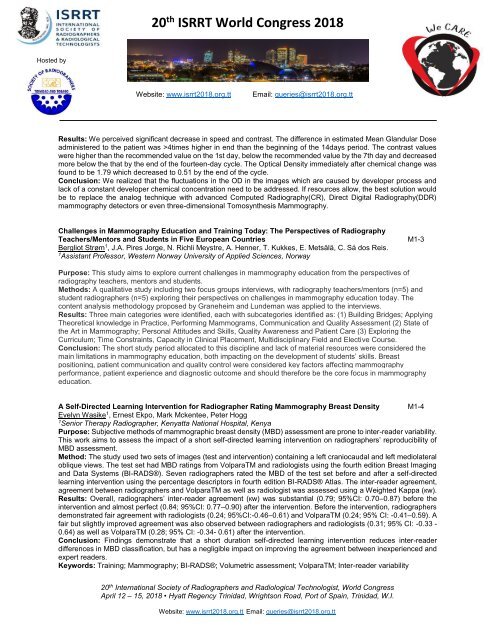Trinidad-and-Tabago-Congerss-Abstract-Book
You also want an ePaper? Increase the reach of your titles
YUMPU automatically turns print PDFs into web optimized ePapers that Google loves.
20 th ISRRT World Congress 2018<br />
Hosted by<br />
Website: www.isrrt2018.org.tt<br />
Email: queries@isrrt2018.org.tt<br />
Results: We perceived significant decrease in speed <strong>and</strong> contrast. The difference in estimated Mean Gl<strong>and</strong>ular Dose<br />
administered to the patient was >4times higher in end than the beginning of the 14days period. The contrast values<br />
were higher than the recommended value on the 1st day, below the recommended value by the 7th day <strong>and</strong> decreased<br />
more below the that by the end of the fourteen-day cycle. The Optical Density immediately after chemical change was<br />
found to be 1.79 which decreased to 0.51 by the end of the cycle.<br />
Conclusion: We realized that the fluctuations in the OD in the images which are caused by developer process <strong>and</strong><br />
lack of a constant developer chemical concentration need to be addressed. If resources allow, the best solution would<br />
be to replace the analog technique with advanced Computed Radiography(CR), Direct Digital Radiography(DDR)<br />
mammography detectors or even three-dimensional Tomosynthesis Mammography.<br />
Challenges in Mammography Education <strong>and</strong> Training Today: The Perspectives of Radiography<br />
Teachers/Mentors <strong>and</strong> Students in Five European Countries M1-3<br />
Bergliot Strøm 1 , J.A. Pires Jorge, N. Richli Meystre, A. Henner, T. Kukkes, E. Metsälä, C. Sá dos Reis.<br />
1 Assistant Professor, Western Norway University of Applied Sciences, Norway<br />
Purpose: This study aims to explore current challenges in mammography education from the perspectives of<br />
radiography teachers, mentors <strong>and</strong> students.<br />
Methods: A qualitative study including two focus groups interviews, with radiography teachers/mentors (n=5) <strong>and</strong><br />
student radiographers (n=5) exploring their perspectives on challenges in mammography education today. The<br />
content analysis methodology proposed by Graneheim <strong>and</strong> Lundeman was applied to the interviews.<br />
Results: Three main categories were identified, each with subcategories identified as: (1) Building Bridges; Applying<br />
Theoretical knowledge in Practice, Performing Mammograms, Communication <strong>and</strong> Quality Assessment (2) State of<br />
the Art in Mammography; Personal Attitudes <strong>and</strong> Skills, Quality Awareness <strong>and</strong> Patient Care (3) Exploring the<br />
Curriculum; Time Constraints, Capacity in Clinical Placement, Multidisciplinary Field <strong>and</strong> Elective Course.<br />
Conclusion: The short study period allocated to this discipline <strong>and</strong> lack of material resources were considered the<br />
main limitations in mammography education, both impacting on the development of students’ skills. Breast<br />
positioning, patient communication <strong>and</strong> quality control were considered key factors affecting mammography<br />
performance, patient experience <strong>and</strong> diagnostic outcome <strong>and</strong> should therefore be the core focus in mammography<br />
education.<br />
A Self-Directed Learning Intervention for Radiographer Rating Mammography Breast Density M1-4<br />
Evelyn Wasike 1 , Ernest Ekpo, Mark Mckentee, Peter Hogg<br />
1 Senior Therapy Radiographer, Kenyatta National Hospital, Kenya<br />
Purpose: Subjective methods of mammographic breast density (MBD) assessment are prone to inter-reader variability.<br />
This work aims to assess the impact of a short self-directed learning intervention on radiographers’ reproducibility of<br />
MBD assessment.<br />
Method: The study used two sets of images (test <strong>and</strong> intervention) containing a left craniocaudal <strong>and</strong> left mediolateral<br />
oblique views. The test set had MBD ratings from VolparaTM <strong>and</strong> radiologists using the fourth edition Breast Imaging<br />
<strong>and</strong> Data Systems (BI-RADS®). Seven radiographers rated the MBD of the test set before <strong>and</strong> after a self-directed<br />
learning intervention using the percentage descriptors in fourth edition BI-RADS® Atlas. The inter-reader agreement,<br />
agreement between radiographers <strong>and</strong> VolparaTM as well as radiologist was assessed using a Weighted Kappa (кw).<br />
Results: Overall, radiographers’ inter-reader agreement (кw) was substantial (0.79; 95%CI: 0.70–0.87) before the<br />
intervention <strong>and</strong> almost perfect (0.84; 95%CI: 0.77–0.90) after the intervention. Before the intervention, radiographers<br />
demonstrated fair agreement with radiologists (0.24; 95%CI:-0.46–0.61) <strong>and</strong> VolparaTM (0.24; 95% CI: -0.41–0.59). A<br />
fair but slightly improved agreement was also observed between radiographers <strong>and</strong> radiologists (0.31; 95% CI: -0.33 -<br />
0.64) as well as VolparaTM (0.28; 95% CI: -0.34- 0.61) after the intervention.<br />
Conclusion: Findings demonstrate that a short duration self-directed learning intervention reduces inter-reader<br />
differences in MBD classification, but has a negligible impact on improving the agreement between inexperienced <strong>and</strong><br />
expert readers.<br />
Keywords: Training; Mammography; BI-RADS®; Volumetric assessment; VolparaTM; Inter-reader variability<br />
20 th International Society of Radiographers <strong>and</strong> Radiological Technologist, World Congress<br />
April 12 – 15, 2018 • Hyatt Regency <strong>Trinidad</strong>, Wrightson Road, Port of Spain, <strong>Trinidad</strong>, W.I.<br />
Website: www.isrrt2018.org.tt Email: queries@isrrt2018.org.tt


















